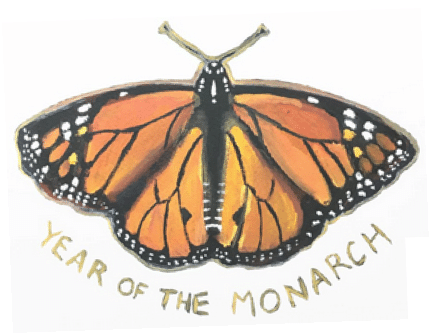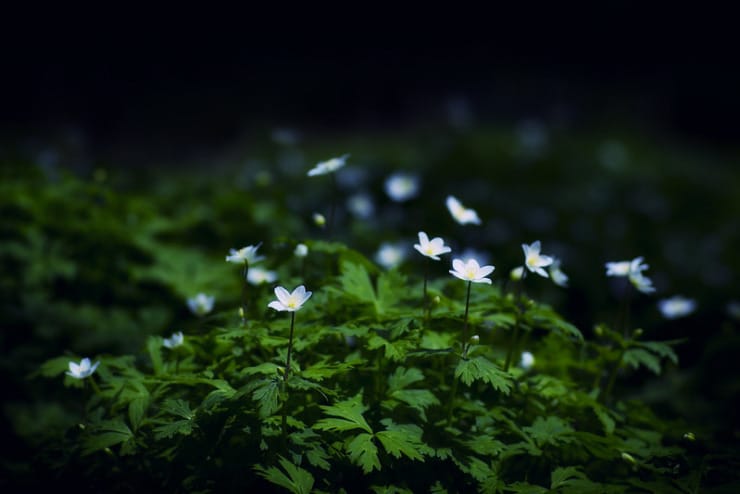Confession time. In the past, I didn’t really think about butterflies, much less monarchs. To me, they were members of the general category of bugs, all of which I energetically avoided. My tendency toward entomophobia didn’t help the matter.
A few years ago, though, a friend showed up at my door clutching a chrysalis for my, um, viewing pleasure, and, to my surprise, my perception changed. As this caterpillar metamorphosed in my home, and as I learned about its migratory path, intergenerational memory, and orientation mechanisms, a transformation occurred in my mind as well. The pupating insect changed from a bug into a singular and distinctive piece of life, worthy of notice.
And notice I did. Once I was paying attention, I began to see monarchs everywhere. Sometimes this happened on purpose, for instance, during a planned visit to Natural Bridges State Park in Pacific Grove, California, where I saw massive clusters of migrating monarchs shimmering on trees.
More often, though, these monarch encounters were serendipitous—articles in magazines, drawings and descriptions on walls and park signs, and once, in the form of giant sculptures mounted in the Minneapolis Mall of America, which I visited during a flight layover.
Now, to honor Tweetspeak’s Year of the Monarch, there is milkweed (specifically, butterfly weed) growing in my Indianapolis backyard, my attempt to help shore up the deeply depleted monarch habitat. After the planting, it occurred to me that, aside from my Pacific Grove visit, I’d seen very few live monarch butterflies—only written descriptions and artistic versions of them.

***
A few years ago, my former college roommate and I reconnected in Austin after a decades-long hiatus. We enjoyed our reunion so much that we’ve visited one another several times since then—most recently, in Buda, Texas (which, to my acute disappointment, is pronounced “Byoo-dah,” not “Buddha”).
When I consulted Google Maps before my trip, my eyes brightened at a featured attraction near Buda, and I texted N. with a strange activity request for a roommate reunion: a wildflower center. Her unfeigned enthusiasm for my off-the-beaten-path suggestion reminded me why we’d always gotten along so well.
Established in 1982, the Lady Bird Johnson Wildflower Center features 284 acres of gardens and managed wildlands and 900 species of plants representing the 12 major ecoregions of Texas. Johnson’s objectives included supporting natural plants, creating sustainable landscapes, and conserving resources, and her dedication to these causes influenced much legislative and policy change in the late 20th century. In her words, “[t]he environment is where we all meet, where we all have a mutual interest; it is the one thing all of us share.”
It was a wonderfully warm day, which I particularly enjoyed given that I’d just experienced Indiana’s usual November temperature dip. We walked the extensive grounds and took in the native plants—laurel and verbena and bitterweed and salvia and so many, many more.
Eventually, N. and I made our way toward the Weber Pollinator Habitat Garden—a massive monarch waystation.
Then I saw it—exactly what I’d hoped for: a flash of orange and black.
***
Jenny Odell’s insightful book, How to Do Nothing: Resisting the Attention Economy, warns us against the numerous factors and forces co-opting and even monetizing our attention. She urges us to reclaim that attention and to direct it instead toward what’s most important and interesting to us, in order to live intentionally and according to our own values and desires.
Strange as it may seem, my increased attention to the monarch butterfly has felt like such a reclamation, á la Odell.
Instead of dismissing a “bug,” I am seeing the magnificent qualities and capabilities of a tiny piece of creation, and becoming more conscious of the million living wonders I’ve been overlooking. Instead of feeling frustration at the lack of attention to species extinction, I am seeing the people and organizations responding to this depleting population with love and care, with pollinator gardens and media campaigns and action plans. Instead of feeling helpless against forces beyond my control, I am seeing my ability to act—to donate, advocate, write, and of course, plant milkweed in my own yard.
And when I do catch sight of the rare monarch, it looks wondrous, unrepeatable, and far too precious to lose to oblivion. That day in Lady Bird Johnson’s gardens, a surprise was in store for me. N. and I saw at least ten monarch butterflies, often in groups of three or four, dipping in and out of the pollinator plants, flitting together in loops and spirals before disappearing into the tall grasses.
I spent some time trying to capture them on my phone camera, then realized I was missing the point. I stopped for a moment and took in the Texan warmth and the joy of laughing and talking with my old friend as we, of all things, sought out butterflies. I marveled at the coincidence of both of us living on the monarch’s migratory path—in Austin and Indy.
Closing my eyes, I tried to hold it all—the delight, the fun, the laughter.
Then, I heard a voice—internal and urgent. Open your eyes, Dheepa—don’t miss a thing!
Photo by Hiroyuki Takeda, Creative Commons license via Flickr. Post by Dheepa R. Maturi.
- Morphing: Lessons from the Year of the Monarch - October 23, 2024
- Year of the Monarch: Butterfly Kisses—A Romantic Comedy - August 7, 2024
- Year of the Monarch: In Sync — a Communal Poem for the Monarch Butterfly - April 11, 2024

Mary Redman says
I enjoyed your essay, Dheepa (as always). I want you to know that I am reading (slowly) How to Do Nothing, based upon your recommendation. I have a recommendation for you, as well. If you have not read the novel Flight Behavior by Barbara Kingsolver, you ought to do so. It is about the monarchs.
Thanks again for an enjoyable read and a chance to see the brighter side of the very real plight that monarchs face.
Dheepa R. Maturi says
Mary, thank you so much for reading–I always appreciate it! Looking forward to discussing How To Do Nothing with you–I found that it put a framework around so many of my current concerns about my tech-related behaviors. And oh yes, I loved Kingsolver’s Flight Behavior (what a wonderful author!) and even discussed it in a post! https://www.tweetspeakpoetry.com/2023/06/26/gift-of-the-monarch-butterfly/
Bethany Rohde says
Dheepa, thanks so much for sharing this beautiful piece. I appreciate the admonishment you bring forward here from Jenny Odell, “to reclaim that attention and to direct it instead toward what’s most important and interesting to us, in order to live intentionally and according to our own values and desires” and the ways that you are unfolding that for yourself.
Such an important reminder at the end of your piece, to open our eyes, and stay connected to what is beautiful, present, and possible right in *this* very moment.
Dheepa Maturi says
I appreciate this so much, Bethany! Odell’s book was truly wonderful–it made me pay attention to my attention, so to speak. You’re correct that so much is unfolding during this Year of the Monarch. Thank you so much for reading–I am so grateful!
Bethany Rohde says
It’s completely my pleasure. Love reading you work and look forward to hearing more about this unfolding or whatever else you enjoy down the road. Happy New Year’s Eve-Eve!
And – I am so happy for your about your Pushcart nominations! (H/T Ann Kroeker) I just now looked up the publications you were nominated for, and discovered that one is called, “Unfolding”? I did not realize this when I commented. Wow. I want to go read it. Congrats again, Dheepa!
Dheepa Maturi says
Bethany, thank you–this is so kind of you! I was shocked, thrilled, over-the-moon. I’m so grateful to Ann for sharing the news–she has been the source of so much good in my life. And your using the word “unfolding” was a lovely little coincidence–though, these days I’d call it serendipity, or even kismet!
L.L. Barkat says
This totally made me laugh, Dheepa: “Confession time. In the past, I didn’t really think about butterflies, much less monarchs. To me, they were members of the general category of bugs…”
And, oh, to see this! …. “massive clusters of migrating monarchs shimmering on trees”. Also, the visit to Buda sounds fabulous. Now I am wishing.
I love the idea of directing our attention to that which really counts. I am taking that with me today. And I am also taking with me the utter loveliness of this post… especially the end part where you discovered what you discovered and found encouragement to keep journeying in monarch (and perhaps other) conservation.
Thank you for a fun and beautiful post, Dheepa! 🙂
Dheepa R. Maturi says
Oh, Laura, thank you–I enjoyed writing it as much as I enjoyed the trip! It is amazing to me how one topic–our beloved monarch–can open up in so many ways and in so many directions. I’m so glad you launched the Year of the Monarch!
L.L. Barkat says
Thank you, Dheepa. I’m glad you are glad. 🙂
And now you have me thinking about how the Year of the Monarch has so much synergy with our new annual theme here at Tweetspeak: Journeys …
The monarch is a journeyer, you are a journeyer, and both are taking us places we haven’t been before. Perfect. 🙂
laura says
Oh, how wonderful to witness the clusters of Monarchs resting in the trees! I’ve only seen this in photos and videos and think it must be something one would never forget. Thank you for this lovely post, Dheepa, and for all the ways you care for the Monarchs, which is a way of caring for our world.
Dheepa Maturi says
Yes–truly unforgettable! Thank you so much for reading, Laura, and for your kind note. This has been a special project!